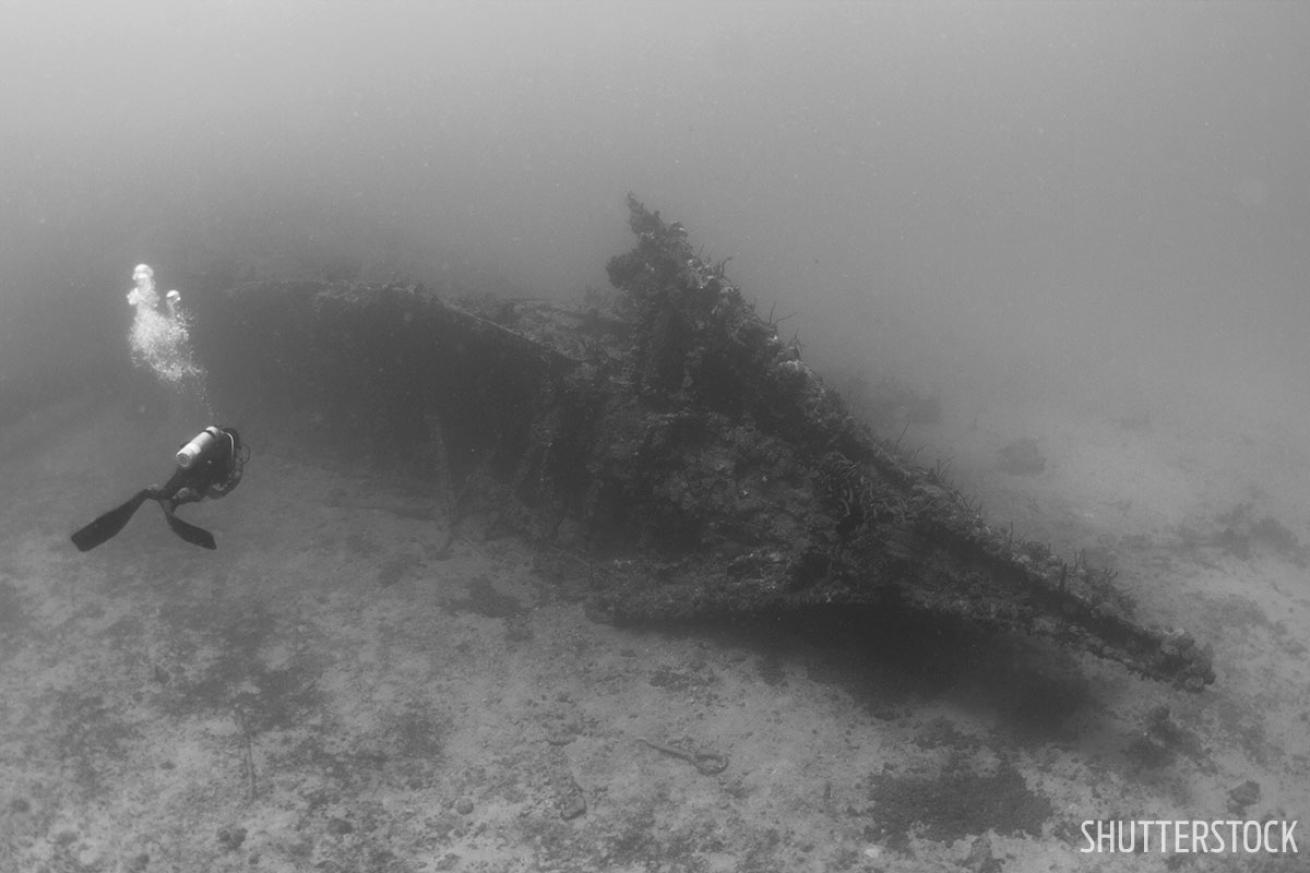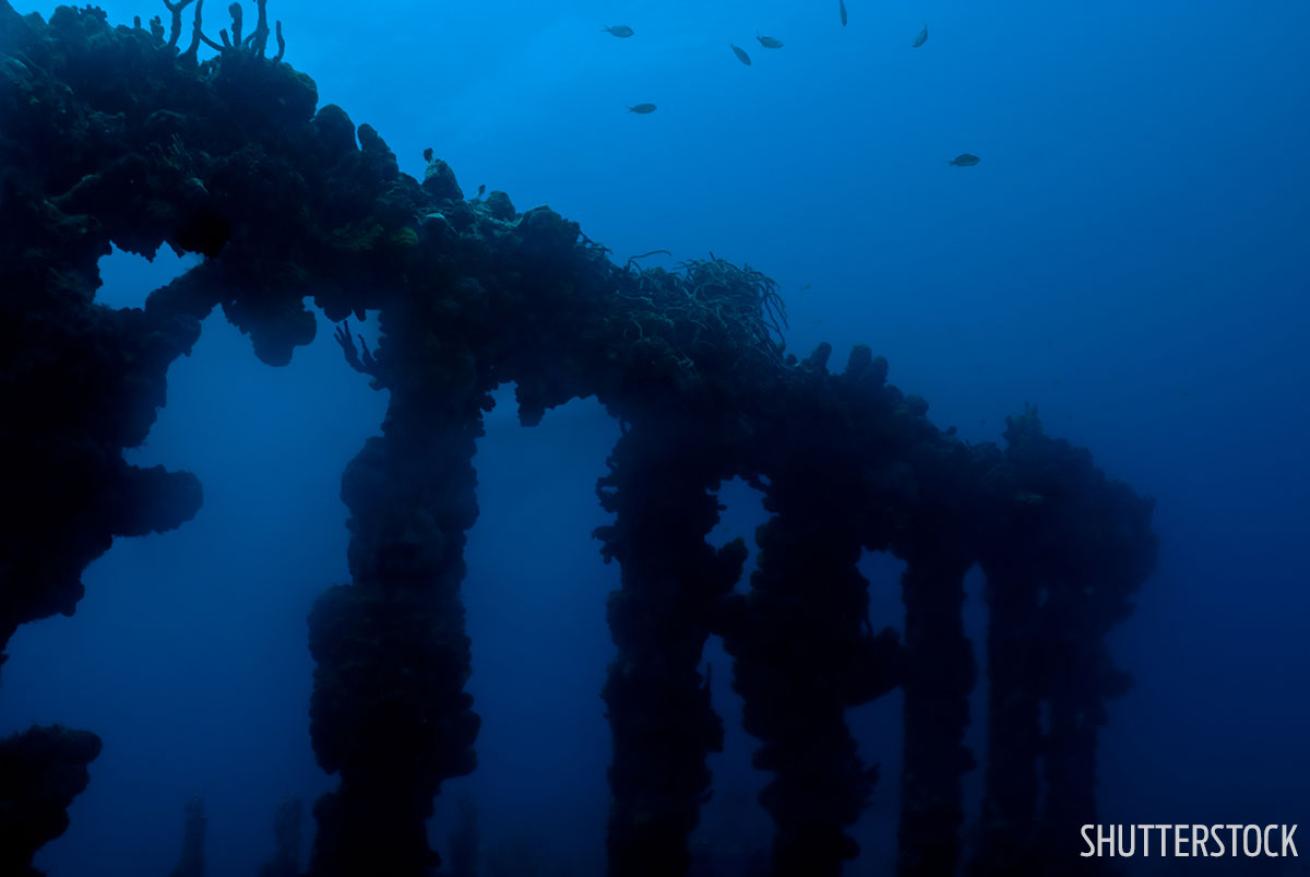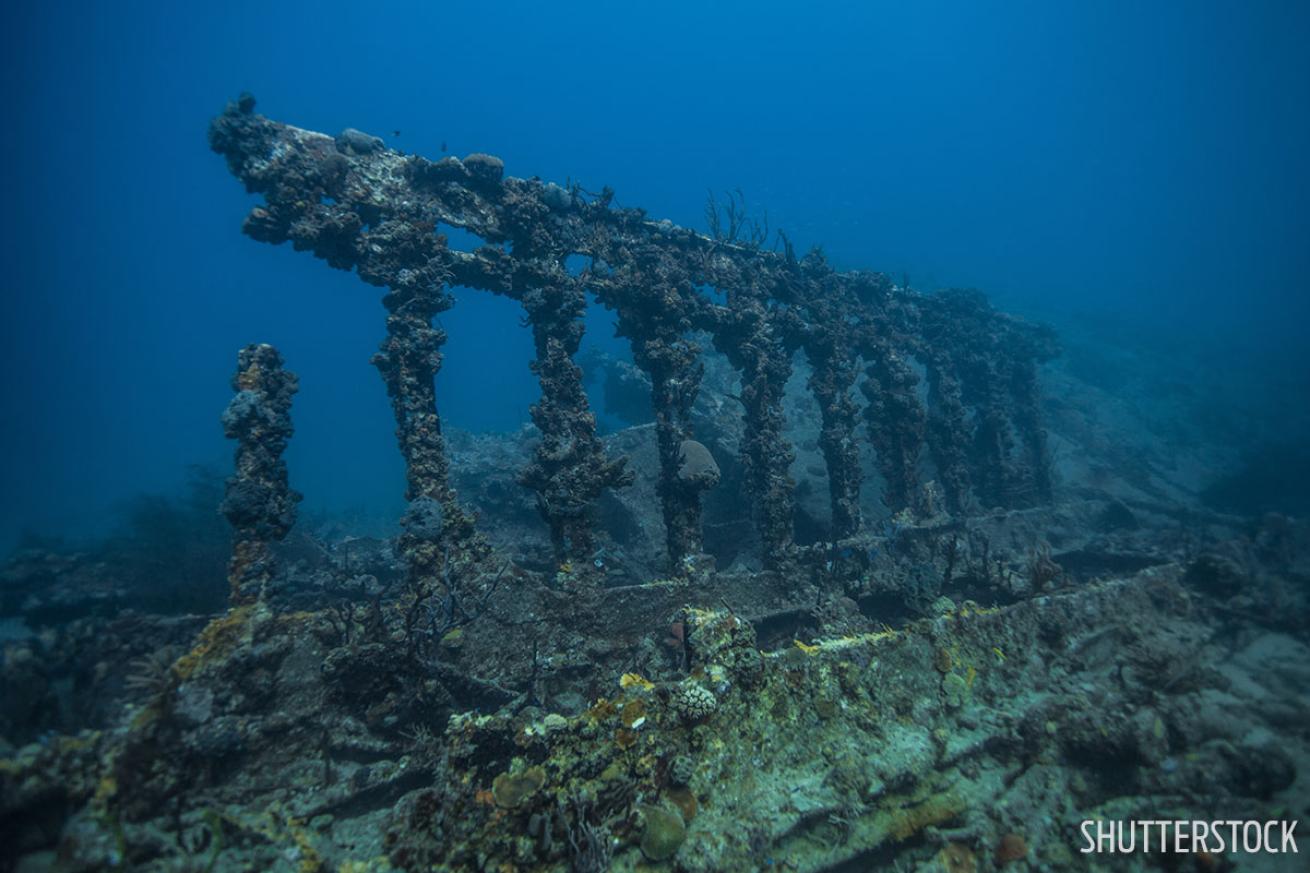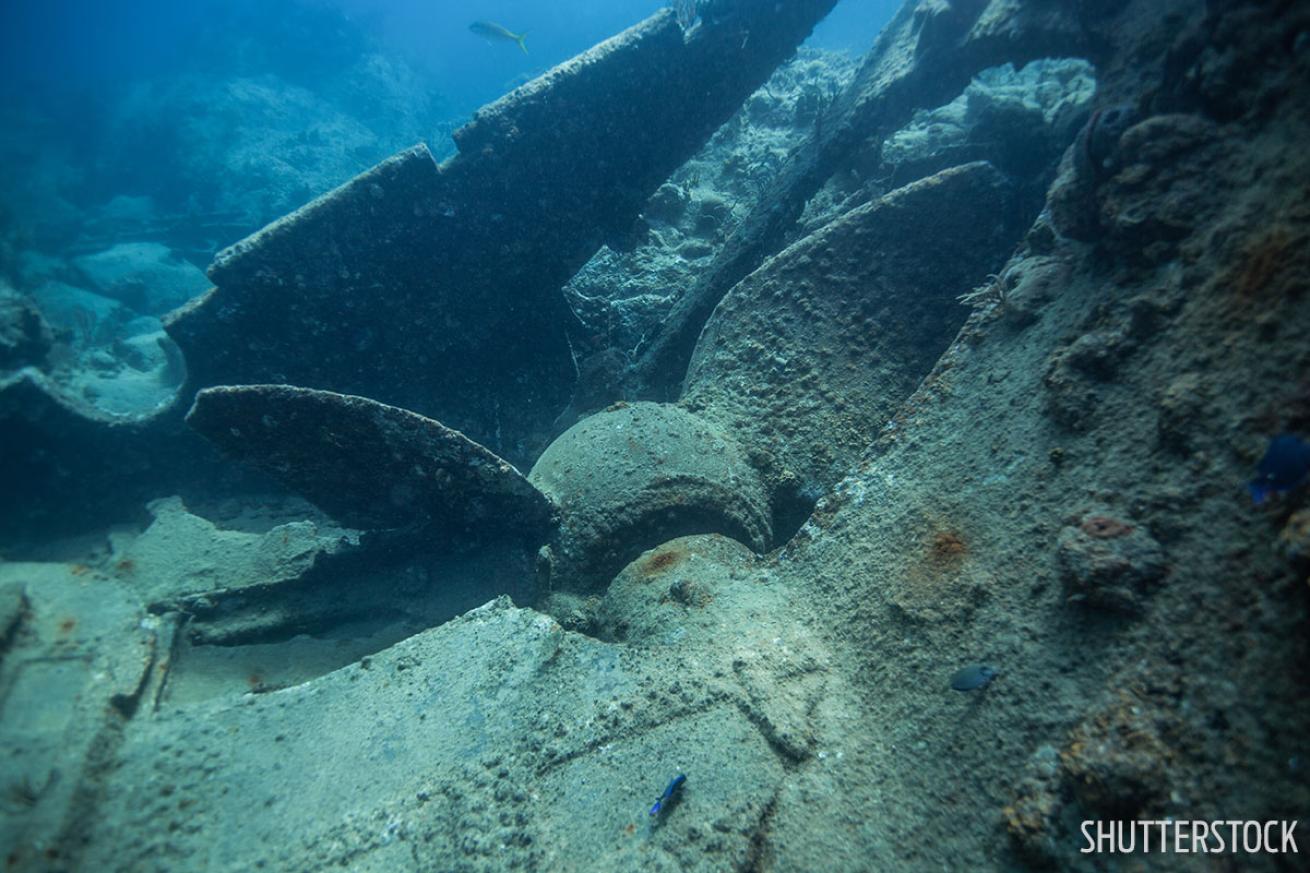History of the BVI's Rhone Shipwreck
How one of the greatest scuba diving sites in the Caribbean was created when an “unsinkable” ship faced a hurricane — and lost.
Divemasters in the British Virgin Islands clamor over who gets to brief scuba divers on the history of the RMS Rhone — sometimes these history lessons even turn into full-blown interactive skits. The tale of man’s hubris and how the “unsinkable” ship finally met its match in 1867 only adds to the experience of scuba diving this real-life Caribbean shipwreck.

ShutterstockThe RMS Rhone sank during a hurricane in 1867
A Brief History of the Rhone
According to the online database Shipwreck World, the Rhone was built in England in 1865 by Millwall Iron Works for the Royal Mail Steam Packet Company. The iron-hulled steamship was 310 feet long with a beam of 40 feet. Rhone was capable of carrying 313 passengers; adventure operator Sail Caribbean notes that the luxurious ship included 253 first-class, 30 second-class and 30 third-class cabins.
The ship was equipped with double masts and sails, but its primary form of propulsion was a single compound steam engine, which was used to drive a gigantic three-bladed bronze propeller. This massive, almost six-foot propeller was the second of its kind ever created for use by a ship and helped Rhone reach speeds up to 14 knots.
Rhone set out on its maiden voyage from Southampton, England, to Rio De Janeiro, Brazil, on October 9, 1865. Upon its arrival, the Brazilian Emperor Pedro II came aboard to tour the cutting-edge steamship.
The ship would continue to travel between Europe, the Caribbean and South America throughout 1865 and 1866 and would encounter its fair share of bad weather. Shipwreck World mentions one particularly malicious storm that severely damaged the steamship and destroyed some of its lifeboats, furniture and cargo. Despite the storm, the ship managed to stay afloat. Under the command of Captain Robert F. Wooley, the Rhone’s knack for weathering many fierce storms earned it a reputation of being “unsinkable.”
The Rhone was moved from its initial Southampton route to a Caribbean route in January of 1867. Before the year was out, it would prove, much like the RMS Titanic 40 years later, that no ship is truly unsinkable.

ShutterstockThe Rhone rests off Black Rock Point on Salt Island.
The Sinking of the Rhone
On October 29, 1867, the RMS Rhone and RMS Conway were both refueling at a temporary coaling station in Great Harbour on Peter Island — the normal refueling stop would have been on St. Thomas, but an outbreak of yellow fever necessitated the temporary outpost — when the barometric pressure began to drop.
This early warning of the approaching storm did not overly concern the two captains. They agreed it was too late in the season for a hurricane and decided to weather what they thought was an early winter storm in the harbor.
When the San Narcisco hurricane hit, the unsuspecting ships were unprepared. Even at anchor, the two vessels were dragged across the harbor.
The ships survived, but the captains feared they would be run aground on Peter Island should the wind pick up again. They decided that the best course of action would be to make a break for a more sheltered harbor during the lull in the storm.
The two captains also agreed it would be best to transfer all of Conway’s passengers to Rhone due to its history for weathering rough seas. Following common maritime practice of the time, passengers aboard Rhone were tied to their bunks to keep them secure should waves toss the ship about.
Having unloaded its passengers, Conway departed for Road Harbour on Tortola via the Sir Francis Drake Channel (it would run aground, but suffer little damage and later be refloated). Before Rhone could follow suit, it was discovered that the ship’s anchor line had become wrapped around a coral head during the storm. The 3,000-pound anchor was stuck fast, and the crew was eventually forced to cut if off after failing to free it. The anchor and chain are still wrapped around the same coral 150 years later.
The barometric pressure had begun to drop once more. Now short an anchor, Rhone’s only option was to make for open water before the tempest began anew. The closest route to the open sea was a channel between Dead Chest Island and Black Rock Point on Salt Island. A shallow reef called Blonde Rock lay within the narrow passage. To avoid this potential hazard Captain Wooley sailed closer toward Black Rock Point.
Sail Caribbean says Rhone was only about 250 yards from open water when it passed the eye of the storm and faced the renewed fury of the category 3 hurricane — the 130-mile-per-hour winds threw Rhone onto Black Rock Point.
Legend has it that Captain Wooley had been (prematurely) celebrating the ship’s escape with a cup of hot tea on deck and that the initial lurch threw him overboard, never to be seen again.
The ship had been running at full steam to make its escape. When the hull was breached, cool sea water met with the super-heated boilers and the resulting explosion tore the ship in half. The Rhone sank almost immediately.
Secured to their bunks, Rhone’s passengers never stood a chance. Rhone was initially carrying 146 passengers, but without knowing how many people were transferred from Conway, it is impossible to know exactly how many perished. Only 23 people survived, all of them crew members. Some of them were found clinging to the topmast, which did not sink below the surface. The bodies that were recovered were buried in a cemetery on Salt Island.

ShutterstockThe mid section of the Rhone shipwreck.
The Legacy of the Rhone
The ship’s topmast remained above the waterline long after the ship went down. It wasn’t until 1950 that the navigational hazard was finally removed when the Royal Navy blew up the stern of the ship.
The wreck and surrounding area, roughly 800 acres, would become the British Virgin Island’s first national marine park in 1980.
Many of the underwater segments of the 1977 thriller The Deep were filmed on the Rhone, requiring actors Jacqueline Bisset, Nick Nolte and Robert Shaw to learn how to scuba dive.

ShutterstockThe Rhone's massive propeller is one of the wreck's most prominent sights.
Scuba Diving on the Rhone
You’ll need at least two dives (minimum) to fully experience the Rhone. That’s because when the ship split apart, the bow drifted just a little before sinking. The two halves are about 100 feet apart at a 90-degree angle. Throughout the site you’ll find schools of yellowtail snappers, sennets, jacks, grunts and more. Turtles are commonly seen around the wreck as well.
The bow sits in deeper water lying on its starboard side. You can still see the foremast, complete with the crow’s nest attached as well as a cannon. The inside of the ship makes for a very open swim through where the exposed ribs of the ship are covered in encrusting sponges and yellow cup coral. Many fish, including one large local barracuda named “Fang,” call the wreck home. At night, you can find arrow crabs, shrimp, lobster and large tarpon.
The stern and mid-section of the Rhone are shallower and can be seen on the same dive. The stern is more broken up than the bow, in part due to the destruction wrought by the Royal Navy in 1950, but still has plenty for scuba divers to see. Sights include the huge bronze propeller (which features its own short swim-through), drive shaft, a group of black-and-white tiles known as “the dance floor,” and the “lucky porthole,” whose glass has remained intact, its metalwork still brassy thanks to the scuba divers who rub it for good luck.
There are a number of artifacts in the area, include massive 100-pound wrenches and a silver teaspoon embedded in the wreckage. Legend has it that the teaspoon belonged to Captain Wooley and that he had been using it to stir his tea the he was thrown into the sea.
There are numerous coral gardens, cleaning stations and nurseries throughout the debris field. Sergeant majors dot the area with their purple eggs, and small pufferfish, damsel fish, green moray and octopus are common.
Even though this is one of the most popular scuba diving spots in the BVI, it is large enough to never feel too crowded. Although you can hit the highlights in two dives, one could easily spend a day scuba diving this magnificent wreck, which also makes a fantastic night dive.
Depth: The stern sits in 35 feet of water while the bow is around 80 feet.
Visibility: Visibility can range from 40 to 100 feet depending on the weather.
Temperature: Water temperatures in the BVI average around 78 degrees Fahrenheit in the winter and 82 in the summer months.
Need to Know: Current can vary significantly, so be aware of changes in the dive conditions. If you get closer to shore you can see the fateful rocks that sank the ship, but be mindful or the surge may throw you onto the rocks as well.
Operators: Cuan Law | DiveBVI | Sail Caribbean Divers










